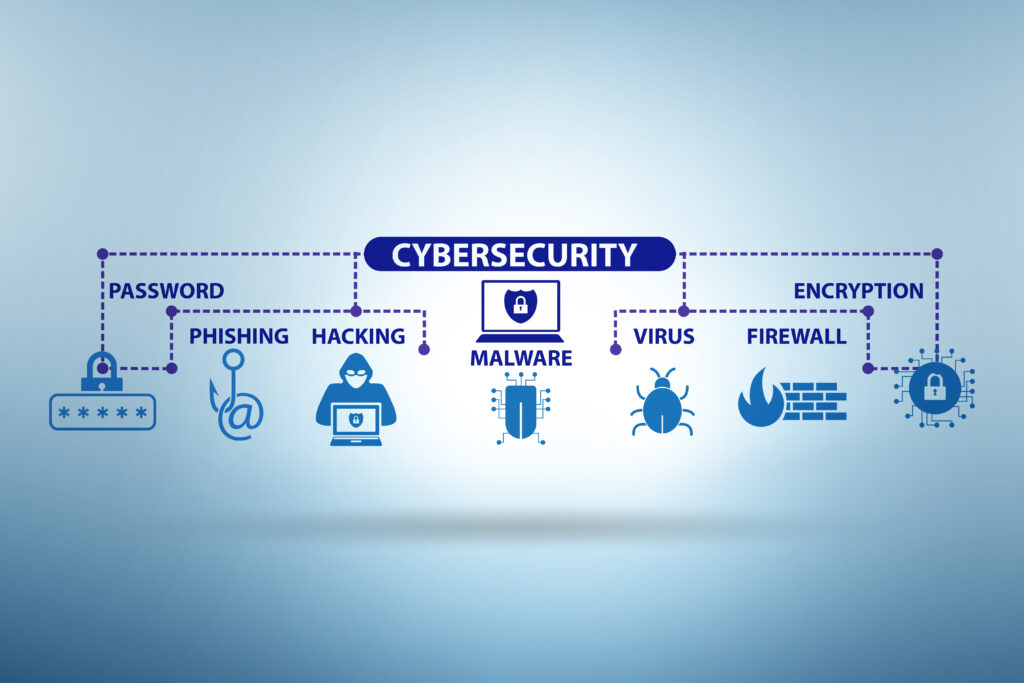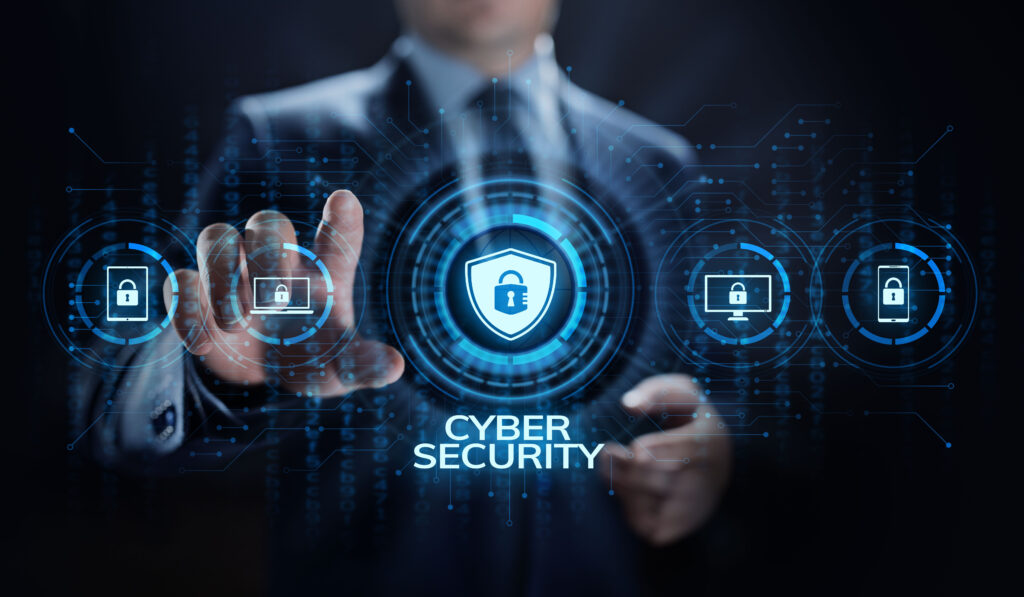Cybersecurity has recently become a well-known issue for consumers and businesses with many headlines about cyberattacks in the news. But what is cybersecurity, and why is it important to everyone? Here is a brief overview:
What is Cybersecurity?
Cybersecurity is the industry in which organizations protect their information, devices, and data from unauthorized access or attack. Just as security officers protect physical spaces and people, cybersecurity protects digital technologies and users from potential danger. This protection covers everything on an organization’s network from the employees’ emails to the customers’ account information and also protects each individual digital device from unauthorized use.
Also referred to as Information Technology (IT) or Operational Technology (OT) security, cybersecurity practices are intended to mitigate threats to the networked systems of organizations from both internal and external threats. While IT can be thought of as devices such as laptops and cell phones, OT refers to systems such as heating and cooling or automated lighting. Cybersecurity professionals have the tools and knowledge to anticipate, prevent, and respond to all types of cyberattacks on an organization and its assets.
Why is Cybersecurity Becoming More Important as Technology Advances?
With the rise of seeking convenience and time reduction in all aspects of life, many organizations rely on digital technologies for daily tasks such as logging into their work email with the password that is saved on their laptop or storing a clients payment information to their account to be used again. These tasks use data that is saved within the organization’s network and could be breached or leaked through a cyberattack.
Each additional device that is added to a network (i.e. cell phone, tablet, computer, printer, camera, smart thermometer, etc.) increases the attack surface that a hacker can exploit and expose the entire network. Once a hacker is in a network, they have access to all the information stored for the organization. This includes employee passwords, customer accounts, client information, and anything else that is kept confidential. With this access and information, a hacker could do a large amount of material and reputational damage to an organization through many different attack avenues. A phishing attack could be created where the hacker pretends to be a client or supplier requiring a payment to a different bank account than previously agreed upon. Or a ransomware attack could be created where the hacker takes control of the entire network and will only agree to release the information and data for a price the organization has to pay.
Additionally, as artificial intelligence (AI) becomes more advanced, cyber criminals are using it to their advantage. Just as AI is decreasing time spent on tasks for employees when writing an email reply or removing a task on their to-do list after marking it complete, cyber criminals are also using it to decrease the time spent on attacks. Attackers using advanced tools, such as AI, are able to perform numerous attacks in the time it took them to complete one attack without these tools. Entering networks that used to take hackers weeks to breach are now taking the AI tools just days, or even hours. This means as AI continues to advance and reduce the time it takes to do tasks, the number of cyberattacks will continue to rise because the cyber criminals will have more time available to them.

What is a Cyberattack?
There are many different types of cyberattacks that could threaten an organization. Of those, here are three of the most common attacks:
1.Malware
Malware is a shortened term referring to malicious software variants that provide access to a computer from an unauthorized user or otherwise causes damage to the computer, without the operator being alerted. Some well-known variants are worms, viruses, Trojans, and spyware. Malware is designed to get around commonly used detection methods, such as purchased security software, that scan for potentially malicious file attachments.
2. Phishing
Phishing is a form of attack that tricks users into giving their personal information or making a payment to the attacker. Users are often tricked by phishing attacks because they appear to be from a legitimate person or company asking for the information or payment.
3. Ransomware
Ransomware is a type of malware that locks and encrypts information on a device or network with threats of erasing, destroying, or leaking the data unless a ransom is paid to the attacker. These cyberattacks essentially hold an organization’s information hostage until a set amount of money is paid, usually within a specified period of time.
Who is at the Highest Risk of a Cyberattack?
The short answer to this question?
Everyone.
There is no such thing as 100% protected from cyberattacks, even with the best possible cybersecurity available. However, cyber criminals are most interested in the “easy” attacks they can perform quickly and move on to their next target. This is because cyber criminals are interested in only one thing – money. If they have to spend a lengthy amount of time attempting to get into a network, they are losing the money they could be making by attacking multiple easier-to-access networks.
A common practice to determine the easier targets for these attackers is to send a phishing attempt to a massive audience and target the employees who were tricked. Organizations that don’t make cybersecurity a top priority are more often found to be the victims of cyberattacks than those with even some cybersecurity measures in place. It doesn’t matter if an organization has 10 employees or 10,000 employees. If the smaller organization has more and/or better cybersecurity, the cyber criminals are more likely to target the larger organization first.
This does not mean an organization has to have a massive cybersecurity budget to keep themselves protected. Being aware of the risks and taking the time to train employees to their potential risks is the first step necessary for an organization to protect itself from these attacks. The next step is for the organization’s leaders to be prepared for an attack. Most executives or business owners do one of three things when facing the threats of cybersecurity – they take action, panic and freeze, or call a friend.
The most common reaction?
Panic and Freeze.
Learning the true vulnerability of an organization can be overwhelming to executives and business owners. It is a scary subject that is becoming more popular in today’s world and in the news. All organizations need to protect themselves to the best of their ability from cyberattacks.
How Can an Organization Protect itself?
As previously stated, the first step in an organization protecting itself is to be aware of the risks and take the time to train employees to their potential risks as well. The next step is to determine if the organization is capable of handling the responsibilities of cybersecurity on its own, or if it would benefit from a partnership with a third-party vendor. Talking with a cybersecurity expert can help executives and business owners fully understand the necessary steps for their specific organization.
Some common tools that are offered by third-party vendors to assist in an organization’s cybersecurity are:
1. Endpoint Detection and Response (EDR)
EDR protects all endpoints, or devices, within an organization’s network. This service can be compared to an alarm system installed in a home or office. Similar to how the alarm system monitors each door and window for intruders, EDR software monitors each computer, cell phone, laptop, and other device for potential threats. When the system detects a threat, it immediately alerts the team of cybersecurity experts to investigate the threat further.
2. Email Spam Filter
Most email platforms come with a built-in spam or junk folder within the user’s inbox. An email spam filter provided by a cybersecurity business will extend beyond the capabilities of these built-in folders. This service is able to block more unwanted emails while still ensuring wanted and needed emails are received by the user. When the filter is set up for an organization, rules are set to determine which emails are received and which are blocked. As time goes on, these rules are changed and adapted to what each user and organization may need.
3. Firewalls
Firewalls keep unwanted traffic from organizations’ networks by blocking malware based on a set of pre-programmed rules. Rules can also be set to prohibit users within the network from accessing certain websites and programs that could be threatening or damaging to the organization. Firewalls prevent unauthorized users, devices, and applications from entering a protected network through authenticating and inspecting any less secure environments before allowing them access.
4. Two-Factor Authentication (2FA)
2FA is a security process to ensure users that are logging into systems are actually who they say they are. This software requires the user to provide two different authentication factors before they are able to access the system or application, such as their password plus an additional security code sent to their cell phone or email address. 2FA makes it harder for hackers to steal users’ identities or access their accounts because they do not have access to the secondary form of authentication.
5. Password Vault
The best protection method for passwords is to use complex, unique, and random passwords containing lowercase and uppercase letters, numbers, and special characters. These types of passwords are much more difficult for hackers to guess or crack, but also much more difficult for users to remember. Installing a password vault program offers a solution to users so they don’t have to remember their complex passwords that have been created for each account or application. These vault programs offer secure protection for all passwords being kept within the software, and often also generate new passwords for accounts that have not yet been set up. This allows users to store all their passwords in one place without the worry that they will get hacked or stolen, while also using complex and unique passwords for each of their accounts.

